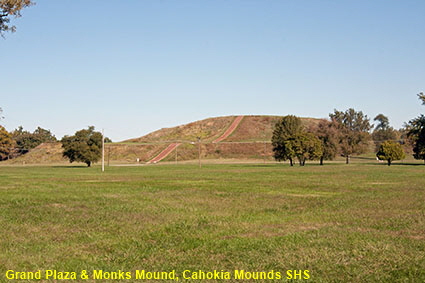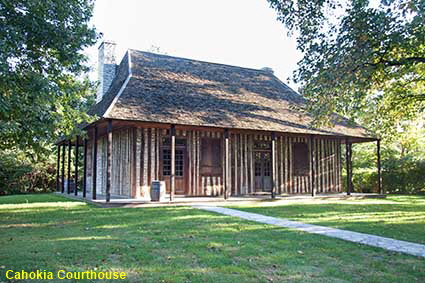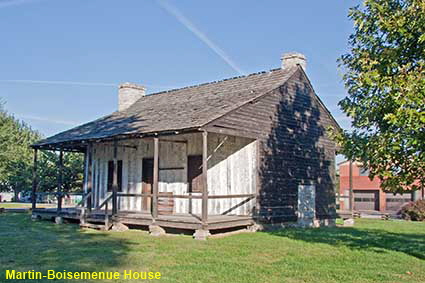Cahokia
Europeans arrived here in 1696 and named their settlement after a local sub-tribe of the Illiniwek Indians, but what really puts Cahokia on the map is much, much older. Around AD 600 indigenous people established at Cahokia a unique civilization of about 50 communities spread over an area of around 890 hectares (2,200 acres). This mound building civilisation declined in the 1300s and had disappeared long before Europeans arrived but it left behind plenty of evidence of its existence. The French established the town of Cahokia about 16 km (10 miles) south east of the mounds as a centre for converting the local Indians to Christianity and for trading both Indian goods and furs. It grew to become one of the largest French colonial towns in Illinois Country. When Britain took over Illinois Country in 1763, many of the occupants of Cahokia fled fearing the British and the imposition of Protestant Christianity, but those that remained maintained their traditions and French remained the predominant language for several decades after the Revolutionary War. Cahokia stands just to the east of the Mississippi River, with St. Louis, Missouri on the opposite bank. Nowadays it is largely a suburb of St. Louis, but the mounds and a couple of old buildings still generate strong echoes of the past.
Grand Plaza & Monks Mound, Cahokia Mounds State Historic Site
Cahokia was the largest pre-Columbian city north of modern day Mexico. At its peak Cahokia is thought to have had up to 40,000 citizens and 120 earth mounds, the highest over ten stories tall. Some mounds were in the form of massive, square-bottomed, flat-topped pyramids on top of which the civic leaders lived. In the Grand Plaza at the centre of the city rose the largest earthwork in the Americas. This mound covers 5.6 hectares (14 acres) and it was 30 metres (100 feet) high, an amazing feat considering that it was built by hand using baskets to carry the soil up the mound. It was given the name Monks Mound by the French monks who discovered it. After 1300, the population declined for unknown reasons and the city had completely abandoned for at least a century when the Europeans arrived. Where the Cahokians went is a mystery as they who do not appear to be related to any major known Indian tribes. The mounds have been preserved as Cahokia Mounds State Historic Site.
Cahokia Courthouse
This former courthouse dates all the way back to 1740, or at least a little bit of the well travelled building may be original. It was originally built in Cahokia as a house back in the days of French Colonial rule using the vertical log poteaux-sur-solle (‘post-on-sill’) construction technique. In 1793 it was purchased by the newly established St. Clair County to become the first county courthouse in the US Northwest Territory. Rapid settlement of the county meant that the building soon became far too small and in little more than a decade the court moved elsewhere. In 1904 the Old Courthouse was bought by the organisers of the St. Louis World's Fair who dismantled it, shipped it to St Louis and rebuilt it as an attraction at the fair. In 1906 the Old Courthouse was again dismantled and shipped to Chicago, where it was rebuilt in Jackson Park.. By 1920 the people of Cahokia wanted their oldest building back. They purchased the Old Courthouse, dismantled it, and rebuilt it on its original site. Each time the Old Courthouse was rebuilt many of the ancient timbers had to be replaced, so not much of the original 18th century building remains. Cahokia Courthouse is open to the public certain days of the week, but unfortunately not on the day that we were in the area.
Click on Minimap to navigate
Martin-Boisemenue House
About 4 km (2.5 miles) from Cahokia Courthouse is a house that is a little younger and considerably less well travelled. The Martin-Boisemenue House in nearby East Carondolet was built in about 1790 by Canadian born frontiersman Pierre Martin. Although it was built after Illinois Country became part of the USA, it was built in the French Colonial poteaux-sur-solle (‘post-on-sill’) style. The Martin-Boismenue House has been restored by the Illinois Historic Preservation Agency and the interior is furnished with period pieces. The house is normally open only by appointment.
DLU130527



To move forwards or backwards through the Illinois trail click the arrows above, or select your next destination on the Minimap.




© Mike Elsden 1981 - 2025
The contents of this page may not be reproduced in full or in part without permission